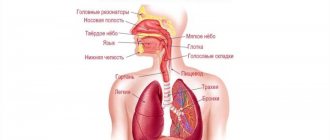To effectively work on the development of voice and speech, you need to understand what sound, voice and speech actually are. Therefore, the purpose of this lesson is to understand what sound, voice and speech are from the point of view of physics and anatomy. To achieve a positive result, you need to understand both aspects. Knowledge of anatomy will help you learn to control your voice , and understanding the physical foundations of sound will help you visualize the results of classes and control the correct sound production .
In this lesson we will look at the physics of sound, the physics and anatomy of the voice, and also learn how the voice works and what is common in the development of voice and speech. We will also provide links to useful services that will help you independently diagnose the capabilities of your voice, if you so desire.
We recommend doing this so that you can more easily and clearly see your progress once you start working with your voice.
So, we have a plan of action for the next lesson, so let's get down to business!
What is sound and voice from a physics point of view?
Let's start with what sound and voice are from a physics point of view. Sound is a physical phenomenon that is the propagation of mechanical wave vibrations .
From a physics point of view, sound has three properties :
- height;
- force;
- sound spectrum.
The height depends on the vibration frequency . Oscillations occur with a certain periodicity and are measured in hertz. Hertz is a unit of frequency for periodic processes in the International System of Units, as well as in the CGS and ICGSS units.
The strength of sound (aka volume) depends on the amplitude of vibrations . Greater amplitude means stronger sound. The unit of sound intensity is decibel (dB). For example: the rustling of leaves is about 10 dB, and a loud conversation is up to 90 dB.
The sound spectrum is a set of additional vibrations or overtones that arise along with the main frequency. This can be observed especially clearly in music or singing. Overtones increase the fundamental tone in multiple ratios (overtone: over, tone) and give the sound additional color, i.e. timbre.
Sounds with periodic (identical and evenly repeating) wave vibrations are called musical tones . Sound vibrations of non-periodic repetition are not musical tones. These are, for example, creaking, crackling and other sounds.
We will talk about the power of sound and sound spectra in the following lessons, but now let's return to the pitch of sound.
Types of sound by height:
- Wave vibrations perceived by the human ear, i.e. in the range of 16-20,000 Hz (hertz).
- Ultrasound is sound waves with frequencies higher than those perceived by the human ear, i.e. above 20,000 Hz.
- Infrasound is sound vibrations having frequencies lower than those perceived by the human ear, i.e. below 16 Hz.
Thus, the higher the vibration frequency, the higher the sound . In the context of our course on voice development, we are interested in the audible range, i.e. 16-20,000 Hz. In the lower part of the range, the sound is subjectively perceived as dull and bassy, in the upper part - as thinner and sonorous. The entire audible range of sounds is distributed along the so-called note-octave scale (see Fig. 1a), built on the basis of a binary system.
The fact is that sounds whose frequencies differ by 2 times (2 times higher or lower) are perceived by ear as similar. This table is well known to musicians, but it is presented to everyone else to understand how great the capabilities of human hearing and, accordingly, the voice are. You don’t have to delve into the designations of notes and octaves for now. We will touch on this topic when we talk about the development of the singing voice.
So we come to what voice is and how it differs from sound. Sound is a broader concept. In the context of our course, sound is absolutely everything we can hear . This is the singing of birds, the rustling of grass, the splash of water, the roar of a motor, the hum of a printer, the clink of glasses and, of course, the human voice.
The voice is the result of the work of the vocal apparatus and sound production organs (we will talk about their structure from an anatomical point of view later). The capabilities of the voice are somewhat less than the capabilities of the human ear, in the sense that even record holders cannot cover the entire gamut of sounds with their voices in the range of 16-20,000 Hz. True, some of them may go beyond the audible range.
Record-breaking voices from the Guinness Book of Records:
- The highest vocal note among men, “F sharp” of the 5th octave (5,989 Hz), was taken by Amirhossein Molai in Tehran (Iran) on July 31, 2021 [Guinness World Records, 2019].
- The highest note among women, “G” of the 7th octave (25,087 Hz), was taken by Brazilian singer Georgia Brown in 2004. Technically this note is not musical. Georgia Brown also holds the world record for the widest vocal range among women. Its range extends from the “G” of the major octave (98 Hz) to the “G” of the 7th octave (total 8 octaves) [Guinness World Records, 2004].
- The lowest vocal note among a woman was 57.9 Hz, which is slightly higher than the A note of the counteroctave. It was taken by Maryana Pavlova (UK) in Wallington, Greater London, UK, June 3, 2021 [Guinness World Records, 2019].
- The lowest vocal note produced by a man is G-7 (0.189 Hz), achieved by singer and songwriter Tim Storms (USA) at Citywalk Studios in Branson, Missouri, USA, on March 30, 2012. The frequency output of Timothy's voice was measured using Bruel & Kjaer equipment (low-frequency microphone, precision audio analyzer and post-analysis laptop) [Guinness World Records, 2012].
By the way, in music it is customary to use not the entire audible range. You can easily verify this by looking at the piano keys. All 88 keys (36 black and 52 white) cover the range from subcontractive A (27.5 Hz) to 5th octave C (4,186 Hz). This is completely sufficient to reproduce any piece of music that is comfortable for the human ear and the way we hear sounds.
You can check the capabilities of your own voice by downloading Pano Tuner and allowing the application access to the microphone. Try to play the highest and lowest note currently available to you, but do not do more than three attempts in a row, because this can lead to overstrain of the vocal apparatus. Record the result and repeat the experience after completing our course. If you have never trained your voice or worked on expanding your range before, you may be able to do so now that you have studied the anatomy of the voice and techniques that help with sound production.
There are options available online without first downloading apps. For example, the Vocal Max service. To start, click on the “Start” button, select the note that is most convenient for you to start with, and play it. As soon as you hit it, it will change color, and the next step will only be possible on any of the adjacent notes, both up and down. If you are not yet familiar with notes, try playing the note “C” of the 1st octave - it is in the range of almost every person. After studying the previous illustration, you can easily find it yourself.
As you play each of the subsequent notes, they will also change color. When you exhaust your range, click “Finish” and save the result, say, as a screenshot. Most likely, after 1-2 months of training, your range will become wider.
And finally, the speech. Speech is a joint result of the work of the vocal apparatus and thinking . If in order to make simple sounds (screaming, crying, moaning and others), we only need to use the vocal apparatus, for speech we need a preliminary understanding of what you want to say. For speech, a smaller vocal range is used than for various types of sounds - screaming, crying, moaning and others.
There is a distinction between internal and external speech, but in the context of our course we are interested, first of all, in the development of external speech, where the organs of sound production are involved. At the same time, beautiful external speech is impossible without the development of internal speech, i.e. planning and control “in the mind” of speech actions, internal pronunciation of planned phrases.
By the way, in our course you will learn that sound production can also be planned! “In your mind” you can rehearse not only the text of the future message, but also its emotional intensity, volume, and pitch. A meaningful approach to sound production, knowledge of the anatomy of the voice and an understanding of how certain movements and positions of the sound production organs affect your voice and your speech will help with this.
What is sound and voice in terms of anatomy?
Voice is a sound produced by exhaled air, vibration of the vocal cords and resonance. In this case, the vocal folds (or cords - we will use both terms) are involved only in fine control of the voice, and the main work is done by air flow and resonance.
To understand how the voice works and how speech is formed, we need to study the structure of the human sound apparatus. Let's divide the problem into two components: how the vocal apparatus works and how hearing works. Let's start with the voice.
General structure of the respiratory system and vocal apparatus:
| 1 | lungs; |
| 2 | rib cage; |
| 3 | diaphragm; |
| 4 | abdominal Press; |
| 5 | bronchi; |
| 6 | trachea; |
| 7 | larynx; |
| 8 | vocal cords (located inside the larynx); |
| 9 | pharynx; |
| 10 | oral cavity; |
| 11 | nasal cavity with accessory cavities; |
| 12 | elements of the nervous system that conduct and transmit signals connecting the vocal organs with the brain centers. |
We consider the respiratory system and vocal apparatus as a single whole, because sound production occurs due to exhaled air. We strongly recommend that you first study the structure of the respiratory system and vocal apparatus in the most general schematic form, and only then move on to a detailed study, analyzing illustrations with an increasing number of elements and details.
Here's a simple illustration:
Here's a more complicated one:
This approach will allow you not to get confused when studying sound production and voice formation, and to maintain a gradual transition from simple to complex.
Simple illustration:
And more complex:
Now let's move on to how exactly sound production occurs. Let's look at the process step by step.
Sound production - how it happens:
- Sound is produced by the flow of air exhaled from the lungs.
- The air stream moves the vocal folds.
- The pitch of the voice is determined by the length and tension of the ligaments. The stronger the tension, the higher the voice. The longer the vocal cords, the lower the voice.
- The strength of the voice is determined by the tightness of the ligaments and air pressure.
- The degree of tension on the vocal cords changes as the internal muscles of the larynx contract.
- The vocal cords are attached to the arytenoid cartilages and to the thyroid cartilages, the displacement of which determines the position of the ligaments.
- With the help of the tongue, lips, soft and hard palate, one or another shape of the oral cavity is created, which determines the production of one or another sound.
This is how the voice is formed:
And this is the speech:
Let us dwell in more detail on the dependence of voice pitch on ligaments . The pitch of the voice, i.e. the frequency of sound vibrations depends on both the voltage and the length of the vocal cords.
It is easier for short ligaments to vibrate, so they can perform a greater number of oscillations per unit time. The more vibrations, the higher the voice. Long ligaments are harder to “swing”, so they are capable of making fewer vibrations per unit time. The less hesitation, the lower the voice.
This phenomenon can be figuratively compared to the wingspan of birds. Thus, the wing beat speed of a miniature hummingbird ranges from 50 to 80, and in some species up to 200 beats per second. And such a noticeably larger bird like the stork makes only 2 (two!) wing beats per second.
Let us illustrate what has been said:
Looking at the diagram of the dependence of voice pitch on the length of the vocal cords, we can roughly say that basses are our storks, and sopranos are hummingbirds. This division, adopted in academic opera, is very arbitrary. There are people whose vocal range extends far beyond any one voice type.
For example, singer Dimash has a range of 6 octaves + 5 semitones from the “A” of the counter octave to the “D” note of the 5th octave. Thus, his voice fully accommodates the range in which baritone, tenor, alto and soprano sing, and also captures the upper part of the bass register and part of the so-called “whistle register”, which extends beyond the upper notes of the soprano. Having watched Dimash’s performance, you can hear how delicately he plays the notes of the composition’s melody (not to be confused with the lyrics of the song!) in the whistle register:
Here we come close to the difference between the formation of voice and the formation of speech. From the first part of our lesson, you already know that voice is a broader concept than speech . A voice without speech is possible - for example, screaming, moaning, crying, but speech without a voice is in no way possible.
The position of the tongue, lips, soft and hard palate plays an important role in the formation of speech . With their help, we create one or another shape of the oral cavity. This or that shape of the oral cavity allows you to direct the air flow in one direction or another, which determines the difference in sounds obtained with different positions of the tongue, lips, soft and hard palate.
Now a few words about where to direct the air flow. By default, the air flow is directed into resonators - cavities inside the body, reflected inside which it turns into sound. The main resonators for the human voice are the pharynx, oral and nasal cavities, and trachea . The paranasal sinuses, parietal bone, and other cavities inside the skull are also capable of resonating.
This, by the way, explains why we hear our own voice differently than the people listening to us. We perceive wave vibrations from the skull and other resonating cavities that pass through our body. Thus, we perceive the voice we emit not only through hearing. And all our listeners perceive our voice exclusively through their hearing. Therefore, if we want to find out how others hear our voice, we need to make an audio recording - for example, on a voice recorder in a smartphone.
Due to the fact that our course is of an applied nature, it would be appropriate to clarify a couple of points here. In most courses teaching public speaking, vocals, and speech technique, you will come across such a concept as a “chest resonator.” This is a certain convention due to the fact that it is difficult for the average person to imagine where his trachea is, but it is very easy to feel the vibrations inside the chest.
Therefore, if you want to expand the lower part of your vocal range, work on the beautiful sound of the low notes of your voice, you should be prepared for the fact that you will come across formulations like “working the chest resonator”, “exercises to develop the chest resonator”, etc.
Looking ahead, let's say that in lesson No. 2 we will touch on the topic of opening resonators, including the chest one, and explain the terms in more detail, so that in the future you can independently use any books and online resources on in-depth training in speech and/or vocal techniques.
So, resonators are natural amplifiers of our voice inside our body, allowing us to make our voice higher or lower, louder or quieter, and enrich the color of the timbre. Having learned to control the flow of air and direct it to one or another resonator, you will learn to control your voice as you see fit.
To understand what resonance is, you need to remember your youth - approximately the senior or middle group of kindergarten - when we blew on a piece of paper and received a real whistle. Or when they made a “telephone” from cups and string. The point is that the thread must be taut, and only then can sound be transmitted through it. By the way, you can reproduce this experiment now. At the same time, introduce the basics of physics to your children or nephews. Video instructions are attached:
By the way, note that at 01:25 an acoustic guitar comes into the frame. The sound of a guitar is also an example of resonance. Wave vibrations go through the soundboard hole into the body and are converted into sounds, the height of which depends on which string and on which fret you press. In this case, the strings are an analogue of the vocal cords. An electric guitar with a solid soundboard also has resonating cavities inside, they are just not visible from the outside. The electrical part only enhances the mechanical wave vibrations perceived by human hearing. And now we come close to the hearing device .
Anatomy of the vocal apparatus
Elementary anatomy of the vocal apparatus
Brief information about the voice apparatus
All organs involved in voice formation collectively form the so-called vocal apparatus. It consists of: oral and nasal cavities with accessory cavities, pharynx, larynx with vocal cords, trachea, bronchi, lungs, chest with respiratory muscles and diaphragm,
abdominal muscles.
The nervous system, the corresponding nerve centers of the brain with motor and sensory nerves connecting these centers with all these organs, also takes part in voice formation.
Orders go from the brain along the motor nerves to these organs (efferent communication), and through the sensory nerves information about the state of the working organs is received (afferent communication). In fact, the organs involved in voice formation are technical executors of orders from the central nervous system. The work of the vocal organs cannot be considered without connection with the central nervous system, which organizes their functions into a single, integral singing process, which is a most complex psychophysical act.
Voice and hearing
In singing, as well as in ordinary speech, it is necessary to have an apparatus that both creates and perceives sounds. It is well known that a child who completely loses hearing in early childhood (up to one year) as a result of a disease of the hearing organs becomes not only deaf, but also dumb.
Perceived by healthy hearing organs, auditory stimuli from the external environment turn out to be irritants for the nerve cells that control the functioning of the organs of the vocal apparatus. A deaf child has no auditory perceptions and, as a consequence, no stimulation of speech motor centers, and therefore the vocal apparatus does not function.
The connection between hearing and voice is two-way: not only can the voice not be formed without the participation of hearing, but hearing also cannot develop without the participation of the vocal organs. Auditory perceptions are carried out through the activity of the vocal organs; listening to speech, music or singing, we repeat them “to ourselves”, and sometimes out loud, and only after that we perceive them.
When forming and developing vocal skills, the work of the participating organs is constantly being corrected: unnecessary ones are swept aside, necessary movements are consolidated and improved. This whole process is impossible without control of auditory, muscular, and resonator sensations. Hearing is the main regulator of voice.
Vocal organs (1)
The larynx is the organ where the birth of the voice occurs. It is located along the midline of the neck in its anterior section and is a tube, the upper opening of which opens in the pharyngeal cavity, and the lower one directly continues into the trachea.
The larynx performs a triple function (respiratory, protective, vocal) and has a complex structure. Its skeleton is made up of cartilage, movably connected to each other using joints and ligaments and intertwined externally and internally with muscles.
The inner surface of the larynx, like all the cavity organs of our gel, is lined with a mucous membrane. The largest cartilage of the larynx, the thyroid, determines the size of the larynx.
The upper opening of the larynx, called the entrance to the larynx, has an oval shape, formed in front by the movable laryngeal cartilage of the epiglottis.
When breathing, the entrance to the larynx is open. When swallowing, the free edge of the epiglottis bends back, closing its opening. During singing, the entrance to the larynx narrows and is covered by the epiglottis. This phenomenon is of great importance for the formation of artistically valuable qualities of singing sound, for singing support.
If you look into the larynx from above, then on both sides two protrusions of the mucous membrane are symmetrically visible, one above the other. Between them there are small symmetrical depressions - the blinking ventricles. The upper projections are called false (ventricular) folds, and the lower ones are called vocal folds.
False sweets are the same color as the entire mucous membrane of the larynx. They consist of loose connective tissue, glands, and poorly developed muscles that bring these folds together. Glands located in the false folds and in the walls of the ventricles themselves moisturize the vocal folds, which do not contain glands. This function is especially important in singing voice formation.
When breathing, the vocal folds form a triangular slit called the glottis. During voice production, the vocal folds come closer or close, and the glottis closes. The surface of the vocal folds is covered with dense elastic tissue of pearlescent color. Inside them are the external and internal thyroarytenoid muscles. The second, internal ones, are called vocal muscles.
The muscle fibers are located parallel to the inner edge of the fold and in an oblique direction. Thanks to this structure, the vocal fold can change not only its length in a variety of ways, but also fluctuate in parts: the entire width and length or in parts, which determines the richness of the colors of the singing sound.
The vocal folds divide the larynx into two spaces: the supraglottic and subglottic sections. All muscles of the larynx are divided into external and internal. The internal muscles close the glottis and produce voice (they are phonatory muscles). The external muscles of the larynx connect it with the hyoid bone lying above, under the lower jaw, and below with the sternum. These muscles lower and raise the entire larynx, and also fix it at a certain height and set it in the position necessary for voice formation.
Below, the larynx directly passes into the windpipe or trachea (Fig. 3).
The trachea is a tube consisting of cartilaginous rings that are not closed at the back. These cartilaginous plates are connected to each other by ligaments and intertwined with circular and longitudinal muscles. Circular muscles, when contracting, narrow the lumen of the trachea, and longitudinal muscles, when contracting, shorten it.
The trachea is divided into two large bronchi, which, branching like a tree, turn into smaller and smaller ones. The smallest bronchi, the bronchioles, end in vesicles in which gas exchange occurs.
The entire bronchial tree is built like a trachea, only with closed cartilaginous rings. The muscles of the trachea and bronchi are a type of smooth muscle, they are not directly subordinate to our consciousness, they work automatically. As the caliber of the bronchus decreases, there is less cartilage tissue in it, it is replaced by muscle tissue. The small bronchi consist almost entirely of muscle tissue. This structure allows the small bronchi to act as valves that regulate the flow of air from the lung tissue during voice formation.
All bronchi, together with the pulmonary vesicles, form two lungs - right and left, which are placed in the chest cavity, hermetically isolated from the surrounding air, located in the chest.
The chest has the shape of a truncated cone. It is formed in front by the sternum, and in the back by the thoracic spine. The spinal column is connected to the sternum by arched ribs.
The skeleton of the chest is entwined with muscles that take part in breathing. Some are involved in inhalation - inhalers (raise and move apart, expand the chest cavity). Other pectoral muscles lower the ribs, exit and are accordingly called expiratory muscles.
The base of the chest is the diaphragm or thoraco-abdominal obstruction. This is a powerful muscular organ that separates the thoracic cavity from the abdominal cavity. The diaphragm is attached to the lower ribs and spine and has two domes - right and left. During inhalation, the muscles of the diaphragm contract, both of its domes lower, increasing the volume of the chest. The diaphragm consists of striated muscles. Its movement is completely not subject to our consciousness. We can consciously take and hold inhalation and exhalation, but the complex movements of the diaphragm during voice formation occur subconsciously.
The diaphragm regulates the speed of air flow and subglottic pressure when sounds are produced and their strength changes.
The cavities located above the vocal folds: the nasal, oral, pharyngeal and upper part of the larynx are called the supernatant.
The upper part of this tube is the nasal cavity (7). It is composed of the soft tissues of the nose and facial bones of the skull. Along the midline, it is divided by the vertical nasal septum into left and right halves, open in front and behind. Through the posterior openings, the choanae, the nasal cavity communicates with the pharynx (nasopharynx).
In the walls of the nasal cavity there are small openings of the channels through which it communicates with the air cavities located in the facial bones of the skull. These cavities are called paranasal cavities or sinuses. They, like the nasal cavity, are lined with mucous membrane. When she is ill, these cavities can be filled with pus or polypous formations (growths of the mucous membrane), which negatively affects the quality of the singing sound.
The nasal mucosa is rich in blood vessels and glands, as well as villi, due to which the inhaled air, passing through the nose, is warmed, moistened and purified.
Below the nasal cavity is the oral cavity. Its side walls are the cheeks, the bottom of the mouth is filled with the tongue, the front wall is formed by the lips (in a closed state). In the thickness of the lips there are muscles that close them, forming the mouth opening and changing its shape.
The upper wall of the oral cavity is made up of a bony plate that separates the oral cavity from the nasal cavity. It is called the hard palate, which at the back merges into the soft palate, called the velum palate.
The posterior edge of the soft palate, hanging freely in the pharyngeal cavity, has a protrusion in the middle - a small tongue (only humans have it).
The soft palate continues into two symmetrical folds of the mucous membrane diverging downwards at an angle. These folds are called arches; front and rear. The muscles connecting the soft palate with the tongue and larynx pass through the arches.
The soft palate is well innervated by sensory nerves. The muscles located in the thickness of the palate, when contracted, rise and stretch it.
The hard and soft palates together with the front teeth make up the palatine vault. The structure of its parts affects the quality of the singing voice.
At the back, the oral cavity with a wide opening - the pharynx - opens into the pharynx (into its middle section). The pharynx is bounded above by the soft palate, on the sides by the palatine arches, and below by the back of the tongue. The pharynx can narrow and expand. It narrows due to contraction of the muscles located in the arches of the soft palate.
When singing, the pharynx expands; this occurs when the soft palate is raised and the tongue lowered, which is observed during a singing yawn.
The pharynx is a muscular tube, which ends blindly with the upper expanded section under the cranial vault. Tapering downwards, the pharynx passes from the front into the larynx, and from the back into the esophagus. On its anterior surface, as already noted, there are openings: choanae and pharynx.
The pharynx is conventionally divided into three parts: the upper - nasopharynx, the middle - oropharynx and the lower - laryngopharynx. In the pharynx there are separate accumulations of glandular, so-called lymphatic tissue, which form the tonsils. The most significant of them are: the pharyngeal tonsil (lies on the upper wall of the pharynx, on its arch) and the tonsils located between the anterior and posterior palatine arches.
The tonsils perform a protective function: they retain microbes that enter the throat. Acute inflammation of the tonsils is called acute tonsillitis or tonsillitis. A significant enlargement of the tonsils reduces the pharyngeal cavity and negatively affects the formation of the singing voice.
The walls of the pharynx are formed by strong muscles running in the longitudinal and circular directions. Thanks to them, the pharynx can increase and decrease, narrow in various sections (lower, middle, upper) and thereby change its shape, volume, and resonator properties in a variety of ways.
The muscles of the pharynx are entirely subordinate to our consciousness.
Voice formation process
Any elastic body in a state of vibration sets in motion particles of the surrounding air, from which sound waves are formed. These waves, propagating in space, are perceived by our ears as sound. This is how sound is formed in the nature around us.
In the human body, such an elastic body is the vocal folds. The sounds of the speaking and singing voices are formed by the interaction of the vibrating vocal folds and breathing.
When a person desires to sing, all parts of his vocal apparatus come into a state of readiness to perform this action.
The process of singing begins with inhalation, during which air is pumped through the oral and nasal cavities, pharynx, larynx, trachea, and bronchi into the lungs, expanded upon entry. Then, under the influence of nerve signals (impulses) from the brain, the vocal folds close, and the glottis closes. This coincides with the moment when exhalation begins. Closed vocal folds block the path of exhaled air and prevent free exhalation.
Hearing device
Hearing, voice and speech are closely interrelated. If, for example, hearing loss occurs in the pre-speech period, the person will never learn to speak. If there is residual hearing, a person can gain speech skills with the help of a hearing aid, which amplifies the sound enough to be heard.
How does hearing work?
- Outer ear.
- Middle ear.
- The eardrum between the outer and middle ear.
- Inner ear.
- Auditory pathways.
Here's a simple illustration:
And now more complicated:
Sound waves picked up by the outer ear strike the eardrum and cause it to vibrate. The vibrations are transmitted to the middle ear. In turn, the inner ear consists of two components. The first component is the vestibule and semicircular canals , which are responsible for the sense of balance and body position in space, which is why this element is often referred to as the “organ of balance.”
The second component of the inner ear is the so-called cochlea , filled with fluid that vibrates under the influence of wave vibrations. Inside the cochlea there is a special organ (the organ of Corti), which is directly responsible for hearing. It contains about 30 thousand cells that capture sound vibrations and transmit the signal to the auditory zone of the cerebral cortex. Each cell is tuned to a certain frequency, and if some of them die, the person will stop hearing sounds at the frequency for which the dead cells were responsible.
It is also worth talking in more detail about auditory pathways . This is a group of nerve fibers responsible for transmitting nerve impulses from the cochlea to the auditory centers located in the temporal lobes of the brain. Complex sounds (speech, melody, song) are processed and analyzed in the brain. The speed of transmission of an audio signal from the outer ear to the centers of the brain occurs in 10 milliseconds.
An idea of how hearing works, how we hear sounds allows us to better understand what an ear for music is and how to develop it. Most of us have heard the expression that “non-functioning organs atrophy.” This fully applies to the elements of human hearing.
The more cells you make out of those 30 thousand that pick up sound vibrations and transmit the signal to the auditory zone of the cerebral cortex, the more trained your hearing will be. If you listen to sounds at different frequencies, over time you will train every cell of the organ of Corti. They will begin to respond faster to “their” frequency.
Accordingly, the nerve fibers that are responsible for transmitting nerve impulses from the cochlea to the auditory centers will quickly transmit the most accurate information to the auditory centers located in the temporal lobes of the brain. And the processing and analysis of complex sounds will become more detailed and effective each time.
We recommend that everyone who is interested read the article on our website “Musical ear: what is it and how to develop it.” If you are a professional musician, much of the information will be known to you. But if you are not familiar with musical literacy, but are planning a career as a lecturer, speaker, tribune, teacher, psychologist, you should read the article and take some elements of the development of musical ear into service, because this will help you in the further development of your voice and speech after completing our course.
Now let's summarize the lesson. Today you studied the physics of sound, the physics and anatomy of the voice, and also learned how the voice works and what is common in the development of voice and speech. You learned that the main physical characteristics of sound are height, strength and sound spectrum , and you also became acquainted with the structure of the vocal apparatus, hearing organs and understood how sound production and voice formation occur.
Consolidate your acquired knowledge with a test, after which we are waiting for you in the next lesson!
Voice apparatus: specifics of work during sound production
The lower jaw, lips, tongue and teeth are actively involved in the process of sound formation. Depending on the specific structure of these organs or existing defects, an effect such as a lisp or, for example, burr may occur. In the process of practicing vocal skills, they develop:
- breathing apparatus (diaphragm);
- larynx;
- vocal cords;
- vocal resonators.
The vocalist inhales air using a diaphragm, which allows him to take in up to three times more air than with a normal lung inhalation. After this, the exhaled air flow passes through the larynx and finally reaches the ligaments. An air stream breaks through the ligamentous fissure and creates a high-frequency vibration, forming a vocal sound. Next, the sound is sent to resonators - organs that enhance the intensity and volume of the sound wave.
Depending on the length and thickness of the elastic muscles, a low or high sound register is formed (male and female voices). Owners of low basses have the thickness of the ligamentous muscles (no more than 5 mm), while high sopranos have different parameters (about 2 mm). Pearlescent color is a sign of healthy ligaments, which turn red when inflamed. If there is a lot of stress on this organ, problems with sound production may occur: the voice becomes hoarse or hoarse, and medical intervention is required.









![Producing the sound [L] to a child in stages. Articulation gymnastics, speech therapy exercises, pronunciation lessons with pictures](https://doktorobrubov.ru/wp-content/uploads/postanovka-zvuka-l-rebenku-poetapno-artikulyacionnaya-gimnastika-logopedicheskie-uprazhneniya-uroki-330x140.jpg)
